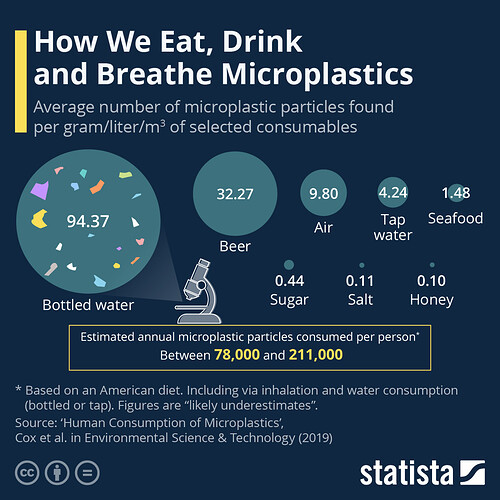everything else equal, would you rather get microplastics from plastic containers or PFAS from restaurant food takeout?
Among the nine media, the highest median contribution of MP intake rate in terms of mass is from air, at 1.07 × 10–7 mg/capita/day. Despite the smaller size (1–10 μm), the intake rates and MP abundance in air are much higher than other media (Figure 2C). At the 95th percentile, MP mass intake distribution from bottled water is the highest among all media, with intake rates of 1.96 × 10–2 mg/capita/day. Some countries are still very reliant on bottled water as their main source of drinking water since their piped water supplies may be contaminated and unsafe for consumption. Therefore, this source is an important route for MP exposure in these countries. The lowest median intake rate is from fish (3.7 × 10–10 mg/capita/day). As mentioned earlier, this can be explained by the highest non-occurrence for fish and from the fact that the median number concentration of MP in fish muscle is only 0.18 particles/g BWW. This suggests that its relevance for MP intake is low relative to other known media.
Branded milks - Are they immune from microplastics contamination? - PubMed => THIS IS FOR TETRAPAK CARTONS IN MEXICO (which don’t have that many microplastics in them - less than drinking water => and these microplastics didn’t come from the tetrapak - however - I wonder if their analytical techniques were sensitive enough to measure super-small plastics)
Microplastic (1–5000 μm) median intake rates are 553 particles/capita/day (184 ng/capita/day) and 883 particles/capita/day (583 ng/capita/day) for children and adults, respectively. This intake can irreversibly accumulate to 8.32 × 103 (90% CI, 7.08 × 102–1.91 × 106) particles/capita or 6.4 (90% CI, 0.1–2.31 × 103) ng/capita for children until age 18, and up to 5.01 × 104 (90% CI, 5.25 × 103–9.33 × 106) particles/capita or 40.7 (90% CI, 0.8–9.85 × 103) ng/capita for adults until age 70 in the body tissue for 1–10 μm particles
OMG AVOID HAND SANITIZER - https://www.mensjournal.com/adventure/why-its-dangerous-use-hand-sanitizer-handling-receipts/
and i thought they were better than plastic
Irregular shape was the only MP characteristic predicting cell death.
Apples (M. domestica). As much as 195,500 micro- and nano-plastic particles were found.
Pears (P. communis). 189,550 micro- and nano-plastics were found.
Broccoli (B. oleracea italica). 126,150 micro- and nano-plastic particles were found.
Lettuce (L. sativa). 50,550 micro- and nano-plastic particles were found.
Carrots (D. carota). 101,950 micro- and nano-plastic particles were found.
…per…gram?
We can hypothesize that the fruits contain more MPs not only because of the very high vascularization of the fruit pulp but also due to the greater size and complexity of the root system and age of the tree (several years) compared to the vegetables (60–75 days for the carrot). Also, the carrot has small, microscopic hairs on the outside of the epidermis of central root and these serve to increase the surface area of the root but survive for only a few days. The moisture content of carrot and apple are similar, from 86 to 89% (Sharma et al., 2012) for carrot and 84–86% for apple (Canet, 1988).
===
and in meat too?!?
Microplastic Contamination of Chicken Meat and Fish … - MDPI
https://www.mdpi.com › pdf
](https://www.mdpi.com/1660-4601/19/20/13442/pdf)
by RZ Habib · 2022 · Cited by 1 — Abstract: Microplastic contamination was found in fish and chicken bought on the market, in food stores and in chain supermarkets in the Middle …
[the units between the studies above used are different - thus impossible to compare between animals and plants, but it MIGHT be possible that the membrane of one is more permeable to them than the membrane of the other]
====
===
(in this case, appetite suppression + air purifiers may be the most robust way to reduce microplastic consumption, damnit). Chewing 2mg of nicotine gum when hungry helps annihilate the appetite (also, DRINK coffee and tea - while coffeemakers may have hot water touch plastic, coffee also excellently suppresses appetite). This may be an argument to eat more calorie-dense foods like nuts.
[important to compare # of particles of air pollution that one inhales in a day [at the WHO limit of 10 ug/m^3] vs # of microplastics one ingests in a day]. Particles of air pollution are not the same as microplastics, but there is a way to compare counts to estimate if [over the past few decades] reductions in air pollution are higher or lower than increases in microplastics
https://www.aljazeera.com › gallery › 2020/12/11 › in-…
Dec 11, 2020 — And over a lifetime, we consume about 20kg (44 lb) of microplastic. Pieces of plastic straws weighing 0.7g, the equivalent of the amount of …
[
How much plastic do you eat? It could be as much as a credit …
https://www.euronews.com › green › 2022/04/11 › ho…
](How much plastic do you eat? It could be as much as a credit card a week | Euronews)Apr 11, 2022 — A recent study has found that people eat five grams of micro and nanoplastics every week. From the most remote depths of the ocean, …
(this is the 2019 study, these numbers are underestimates)
posted more here 195,500 particles of plastic **per gram** of apple? 126,150 particles **per gram** of broccoli? - #4 by AlexKChen - Rapamycin Longevity News
Oh… god… 2022 paper from NIST… trillions of nanoplastics per liter of “paper” coffee cup. Everything from before 2020 may be a huge underestimate.
“On a personal level, I have tried to reduce the exposure of foods and water to plastics in my life,” Zangmeister said. “Much of the plumbing in modern society is plastic, water filters are made from polymeric [plastic] materials, so elimination of plastic exposure can be a real challenge.”
==
The digestion method was optimized for eggs to better isolate MPs, which proved MPs indeed exist in eggs, and the average content was 11.67 ± 3.98 particles/egg. The shape and size range of most MPs were spherical and 50–100 μm. The infrared results showed that the main type of MPs in eggs was polyethylene
Shower Curtains
Cheap shower curtains made of polyvinyl chloride (PVC) are notorious for off-gassing hormone-disrupting phthalates and other noxious chemicals for weeks after their installation.[31](javascript:void(0)) PVC-laden shower curtains are made of flexible plastic, sometimes transparent, that has the look and feel of a thick plastic food wrap—plastic food wraps are also often made of PVC. And you can also recognize PVC from its recycling code #3, which may be on the shower curtain label.
The best plastic-free shower curtain alternative we have found is hemp. Although more expensive than its plastic counterpart, a hemp shower curtain is naturally mildew and mold resistant up to a point. You must ensure your bathroom is well ventilated to allow the curtain to dry completely, and you should wash your curtain with vinegar if you do see any mold developing.
on polylactic acid: Do poly(lactic acid) microplastics instigate a threat? A perception for their dynamic towards environmental pollution and toxicity - ScienceDirect
Your citation:
“When fish ingest microplastics, the microplastics, if remaining in the fish,
mostly reside in the stomach/intestines, which, especially in the case of larger fish, will
be cut away, and for the most part will not constitute food for human consumption.” […] “0.03 ± 0.03 MP[microplastic]/g fish”
Basically, select fish fillets may be likely safer from microplastics than select fruits even after washing.
Why This May Be the Future of Plastic Recycling - YouTube => it may be that PET and polycarbonate (and the plastics w/weirder chemical structures) become less bad than polyethylene or polypropylene simply b/c PET is more molecularly distinct and easier to find unique non-promiscuous enzymes that act on them

